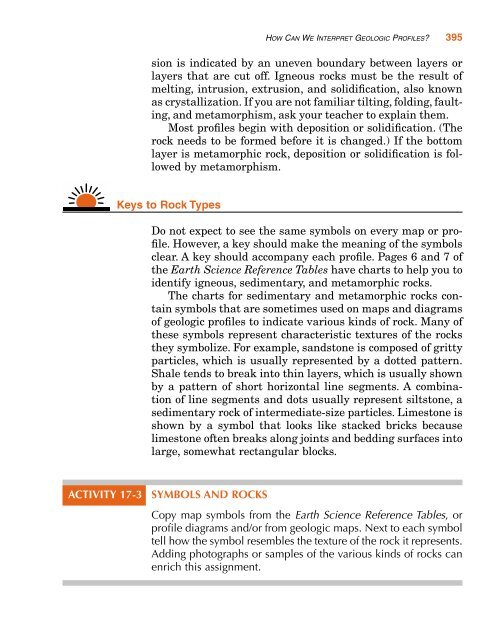Chapter 17 Unraveling Geologic History
Chapter 17 Unraveling Geologic History
Chapter 17 Unraveling Geologic History
You also want an ePaper? Increase the reach of your titles
YUMPU automatically turns print PDFs into web optimized ePapers that Google loves.
sion is indicated by an uneven boundary between layers or<br />
layers that are cut off. Igneous rocks must be the result of<br />
melting, intrusion, extrusion, and solidification, also known<br />
as crystallization. If you are not familiar tilting, folding, faulting,<br />
and metamorphism, ask your teacher to explain them.<br />
Most profiles begin with deposition or solidification. (The<br />
rock needs to be formed before it is changed.) If the bottom<br />
layer is metamorphic rock, deposition or solidification is followed<br />
by metamorphism.<br />
Keys to Rock Types<br />
Do not expect to see the same symbols on every map or profile.<br />
However, a key should make the meaning of the symbols<br />
clear. A key should accompany each profile. Pages 6 and 7 of<br />
the Earth Science Reference Tables have charts to help you to<br />
identify igneous, sedimentary, and metamorphic rocks.<br />
The charts for sedimentary and metamorphic rocks contain<br />
symbols that are sometimes used on maps and diagrams<br />
of geologic profiles to indicate various kinds of rock. Many of<br />
these symbols represent characteristic textures of the rocks<br />
they symbolize. For example, sandstone is composed of gritty<br />
particles, which is usually represented by a dotted pattern.<br />
Shale tends to break into thin layers, which is usually shown<br />
by a pattern of short horizontal line segments. A combination<br />
of line segments and dots usually represent siltstone, a<br />
sedimentary rock of intermediate-size particles. Limestone is<br />
shown by a symbol that looks like stacked bricks because<br />
limestone often breaks along joints and bedding surfaces into<br />
large, somewhat rectangular blocks.<br />
ACTIVITY <strong>17</strong>-3 SYMBOLS AND ROCKS<br />
HOW CAN WE INTERPRET GEOLOGIC PROFILES? 395<br />
Copy map symbols from the Earth Science Reference Tables, or<br />
profile diagrams and/or from geologic maps. Next to each symbol<br />
tell how the symbol resembles the texture of the rock it represents.<br />
Adding photographs or samples of the various kinds of rocks can<br />
enrich this assignment.
















